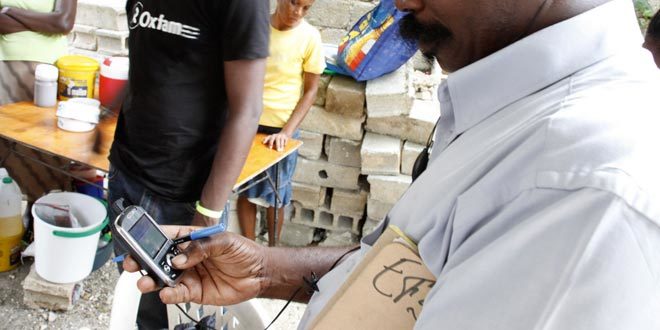Results indicators define essential characteristics of the outcome-based objectives of the project (an outcome-based objective, also known as result, is a statement of the effect that a project has on the community). These characteristics ensure that the project’s outcome-based objectives are “S.M.A.R.T.” (Specific, Measurable, Achievable, Relevant and Time-bound). Results indicators can be quantitative, qualitative, or more commonly, a mixture of both. Moreover, results indicators show how much or how well outcome-based objectives are being or have been achieved; and thus verify the accomplishment of the project’s underlying overall goal. Thus, by tracking performance indicators project teams could make timely and better-informed decisions when determining whether a project is on track or whether implementation correctives are needed.
This article is part of a series:
- The 4 phases of the project cycle
- What is the logical framework approach?
- What do you do during the identification phase of the project cycle?
- Most Significant Change: What it is and how to use it
- Results Indicators: What they are and how to use them
- Means of Verification: What it is and how to use it
Outputs or outcomes?
Results indicators in the logical framework include both: outputs and outcomes, resulting from the activities of the project. Outputs are the goods, services, knowledge, skills, attitudes and enabling environment that are delivered by the project as a result of the activities undertaken. In one word, they are the product of the activity. Outcomes, on the other hand, go beyond and seek to demonstrate to what extent the successful delivery and reception of outputs is impacting the quality of life of the people served. They are the impact of the activity.
Thus, outputs should be demonstrably and effectively received by the intended people served following the successful completion of activities while outcomes would indicate that the expected change(s) in identifiable behaviours by the people served have been realized in response to the successful delivery and reception of these outputs.
A results indicator normally specifies several elements, – albeit not in any particular order. When developing a results indicator consider these elements, but then use your best judgment as to what is appropriate given your situation.
A brief description of these elements follows:
Type of service describes the means to achieve the planned change
Quantity specifies the increase/decrease of the level of the type of services involved.
Quality refers to the national, international or other standards that this change will hopefully adhere to.
People Served refers to which groups of people will benefit from the projects.
Target describes the planned improvement across the total life of the project in terms of people or resources for this results indicator.
Timeline specifies the period when the target for the results indicator is expected to be achieved.
Baseline refers to the comparison between the target and past performance for the results indicator.
Level outcome or output level indicators
By December 2022 (timeline), 20 new workshops (target) from 4 workshops organized during 2021 (baseline) are offered to 30 Male and 20 Female (25-50 years-old) refugee teachers in Nduta, Tanzania (people served) who will enjoy increased access (quantity) to accredited (quality) teacher training (type of service).
Formulating Results Indicators
| Objective: To improve teaching effectiveness of refugee teachers through increasing their skills in lesson plan development techniques by providing teacher training workshops | |||||||
| Quantity | Quality | People Served | Target | Timeline | Baseline | Level | |
| Increase participation in teacher training workshops. | Teacher training workshops accredited by the Ministry of Education. | 30 Male and 20 Female (25-50 years-old) refugee teachers in Nduta, Tanzania | 20 workshops have been organized
|
By December 2022 | 4 workshops were organized during 2021 | Ouput | |
| How this Results Indicator would read: By December 2022, 20 new workshops from 4 workshops organized during 2021 are offered to 30 Male and 20 Female refugee teachers in Nduta, Tanzania who will enjoy increased access to accredited teacher training. | |||||||
How can we transform this output indicator into an outcome?
| Objective: To improve teaching effectiveness of refugee teachers through increasing their skills in lesson plan development techniques by providing teacher training workshops | |||||||
| Quantity | Quality | People Served | Target | Timeline | Baseline | Level | |
| Increased use of knowledge learned during teacher training workshops | refugee teachers implemented session lesson plans developed during training | 5 Male and 5 Female (25-50 years-old) refugee teachers in Nduta, Tanzania | Session lesson plans | By December 2022 | 2 teachers implemented school session lesson plans during 2021 | Outcome | |
| How this Results Indicator would read: By December 2022, 10 refugee teachers from 2 teachers during 2021 representing 5 male and 5 female (25-50 years-old) teachers in Nduta, Tanzania increase their use of knowledge acquired during accredited teacher training in their school settings | |||||||
What is the difference? In the first case (output) we are stating that 20 workshops have been organised for 50 teachers so that they can access qualified training. However, we are not saying whether or not the training has served to improve their pedagogical skills. We are not talking about the impact of the training.
In the second case (outcome) we are saying that 10 of the 50 trained teachers have increased their knowledge through workshops. This time, we are talking about the impact that the training has had on the people served.
How to prove that 10 people actually increased their knowledge will be the subject of the next episode (warning, spoiler….source of verification)!





